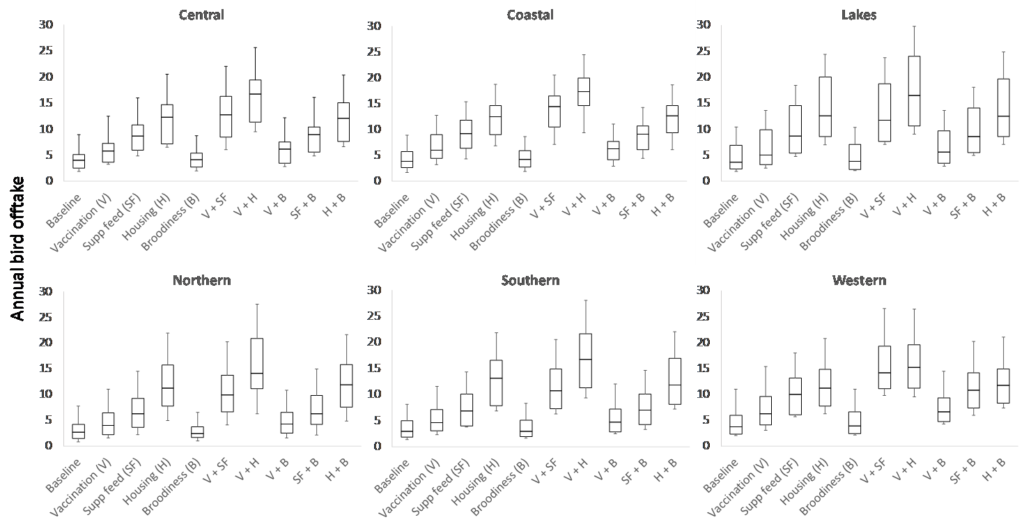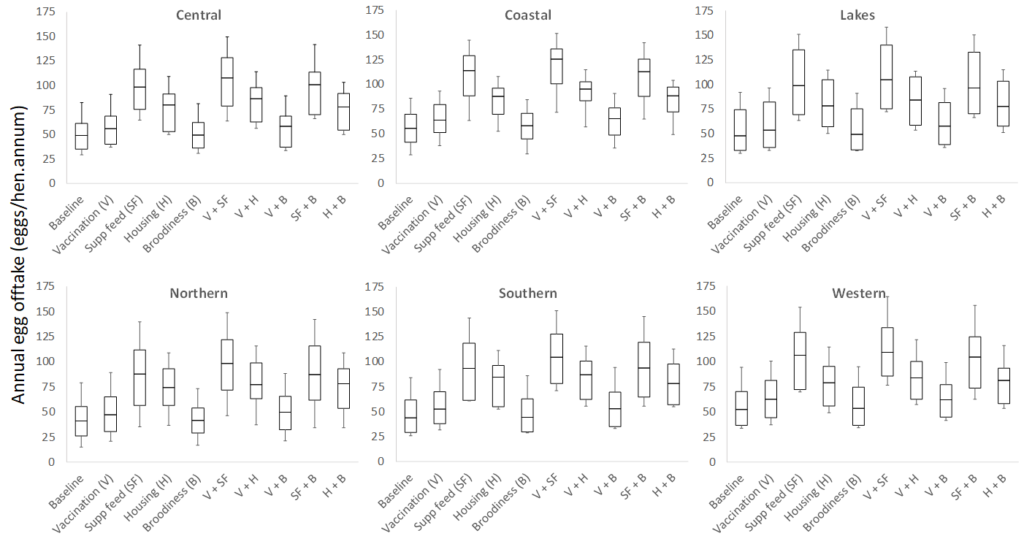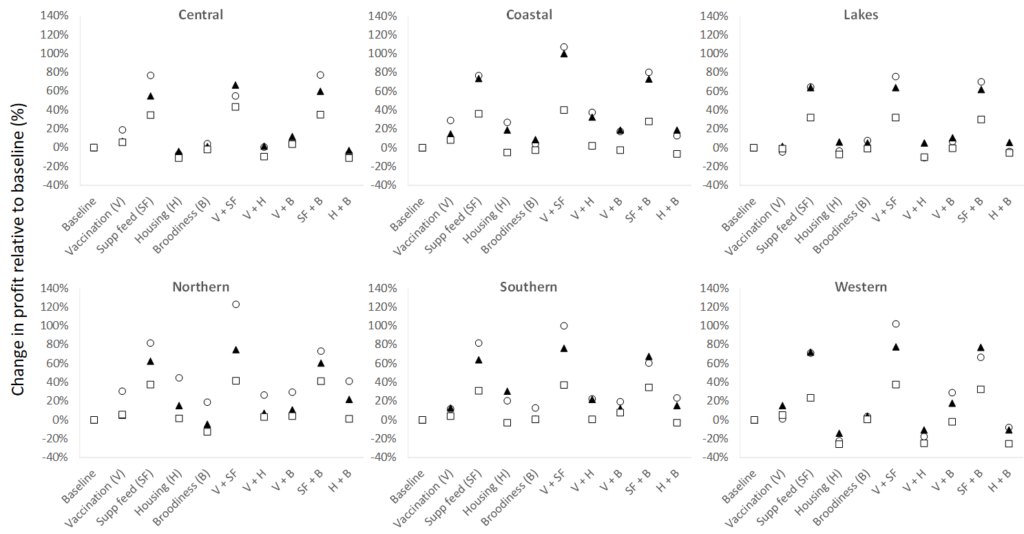Improving poultry production in Tanzania
Most chicken meat and eggs are produced in low input, low yielding systems with indigenous poultry. Chicken meat and egg production can be increased by feeding additional supplements, providing daytime housing and improving health care.
Konga farmers and their chicken flock. Photo credit: Marije van Lidth de Jeude / Transition International.
Current production system
Indigenous poultry supply greater than 70% of demand for chicken meat and egg production in rural areas of Tanzania. Indigenous poultry generally scavenge during the day and are housed at night to reduce losses from predation and theft. There is often very limited supplementary feeding. Egg production is generally low, resulting in lower egg and meat production.
Issues limiting chicken meat production
Low growth rates
Largely caused by inadequate nutrition. Access to supplementary feed is low, and is generally of poor quality.
Low production
Largely caused by inadequate nutrition and broodiness of low genetic potential indigenous birds.
High animal mortality
Largely caused by disease and predation through lack of daytime housing.
Modelled baseline
- Baseline flock size varied between 2-5 birds for the small flocks (10th percentile) through to 27-35 birds for the large flocks (90th percentile).
- Six regions of Tanzania modelled.
- Loss of birds to predation varied between flock class but remained consistent across regions.
- Loss of birds to disease varied between flock class and region.
- Loss of birds to unknown losses varied between region only.
Modelled interventions to increase production
Vaccination
All birds vaccinated against Newcastle disease to reduce disease losses.
Improved feeding management
Supplementary feeding to produce more eggs and reduce age of first lay.
Improved housing
Flock retained indoors during the day to reduce predation.
Control of broodiness
Implemented of control measures to reduced broodiness, thus increase egg production.
Combined interventions
Dual combination of the above-mentioned four intervention options, with the exception of combining supplementary feeding with housing.
Interventions can increase production
Meat production
Median meat production (bird offtake as sum of birds consumed and sold) was 3-4 birds per annum for the baseline system. All interventions increased meat production across all regions. Daytime housing produced the greatest increase in meat production across all regions. Median meat production increased to 11-13 birds per annum. In contrast, controlling broodiness resulted in marginal changes in meat production.
Newcastle disease vaccination combined with daytime housing (V + H) increased median meat production to 14-17 birds per annum (365% increase averaged across the six regions). Vaccination combined with supplementary feeding (V + SF), and control of broodiness combined with daytime housing both increased meat production by around 250%, when averaged across the six regions.
Annual bird offtake (consumed and sold) for the baseline and each intervention option across the six regions of Tanzania (box plots are 10th, 25th, 50th, 75th and 90th percentiles, reflecting the increase in flock size from small to large).
Egg production
Median egg production (egg offtake as sum of eggs consumed and sold) was 41-55 eggs/hen per annum for the baseline system. All interventions increased egg production across all regions. Supplementary feeding produced the greatest increase in egg production across all regions. Median egg production increased to 88-114 eggs/hen per annum. In contrast, controlling broodiness resulted in marginal changes in egg production.
Supplementary feeding combined with Newcastle disease vaccination (SF + V) increased median egg production to 99-125 eggs/hen per annum. Supplementary feeding and the control of broodiness (SF + B) also resulted in a doubling of egg production, to 87-112 eggs/hen per annum.
Annual egg offtake (consumed and sold) for the baseline and each intervention option across the six regions of Tanzania (box plots are 10th, 25th, 50th, 75th and 90th percentile, reflecting the increase in flock size from small to large).
Profitability of interventions
The baseline median profit varied between regions and ranged between ~ TZS1 42,100 and TZS 66,600 per annum. As single intervention options, supplementary feeding increased median profits by 55-74%, relative to the baseline, as a result of the greatest increase in egg production. While housing resulted in the greatest increase in bird offtake, profitability of this option was variable between regions, with profits declining by 14% in the Western region, through to increasing by 30% in the Southern region.
Newcastle disease vaccination combined with supplementary feeding (V + SF) resulted in the greatest increase in profit across all regions of Tanzania. Median profits increased by between 64% in the Lakes region and 100% in the Coastal region, relative to their corresponding baseline profits.
Percentage change in profit, relative to the baseline, for each intervention option across the six regions of Tanzania. Small flocks (10th percentile) represented by a circle, median flocks (50th percentile) represented by a triangle, large flocks (90th percentile farms) represented by a square.
11 USD ~ 2310 Tanzanian Shilling (TZS)
Key messages
Bird and egg offtake increased with all intervention options, although there was minimal change when controlling broodiness.
Combined interventions can be more successful than single interventions.
Combining vaccination with daytime housing resulted in the greatest increase in meat production, and by a rate greater than the sum of each option as single intervention options.
Combining supplementary feeding with vaccination resulted in the greatest increase in egg production, and by a rate greater than the sum of each option as single intervention options.
As flock size increased from small (10th percentile) to large (90th percentile), the percentage increase in meat and egg production declined. This highlights greater benefit of implementing intervention options for small to medium producers.
Supplementary feeding was the most profitable single intervention option. The profitability of housing was variable between regions, and potentially unprofitable in some regions. There was marginal financial benefit in controlling broodiness across all regions. Combining supplementary feeding with vaccination increased profitability for most regions, although not necessarily greater than the sum of each option as single intervention options.
As flock size increased from small (10th percentile) to large (90th percentile), the percentage increase in profit, relative to baseline profit, generally declined. This highlights greater benefit of implementing intervention options for small to medium producers.
Download the Improving poultry meat production in Tanzania factsheet here.
Download the Improving poultry egg production in Tanzania factsheet here.




